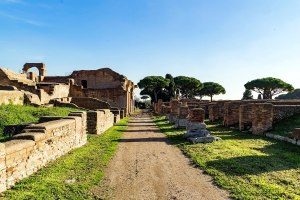
PROCEEDINGS OF THE NATIONAL ACADEMY OF SCIENCES—Researchers infer urban development in ancient Rome from lead-contaminated sediments of an early harbor. Urban contaminants preserved in sedimentary deposits can offer a historical narrative of economic and industrial development. Hugo Delile and colleagues describe how urban development in ancient Rome can be deduced from lead-contaminated sediments from the city’s first harbor, Ostia. Using high-resolution geochemical and isotopic analyses and radiocarbon dating of a sediment core from Ostia harbor, the authors found that lead pipes used in the aquatic infrastructure of Rome and Ostia were likely the source of lead contamination in the sediment sample. Based on the analyses, the authors stratified the core into three main sedimentary units—pre-harbor, harbor, and post-harbor—that described urban development of Rome’s water system, ranging from the system’s initial expansion to its peak during the early-high Imperial period, around 1st century AD. The authors dated the installation of ancient Rome’s lead pipe system to around 2nd century BC, approximately a century and half after the introduction of Rome’s aqueduct system. Together with the sample from Ostia, a sedimentary core analyzed from Portus, a nearby entry port constructed during 1st and 2nd centuries AD, indicated a reduction in lead levels during the Imperial period that corresponded to the contraction of Rome’s water system. According to the authors, the findings might help fill gaps in the history of ancient Rome’s hydraulic infrastructure.
______________________________________
The Via Gherardo in the ancient Roman port of Ostia. Rabax63, Wikimedia Commons
_______________________________________________
Article Source: Proceedings of the National Academy of Sciences news release
Study Article: “Rome’s urban history inferred from Pb-contaminated waters trapped in its ancient harbor basins,” by Hugo Delile et al.
___________________________________________________
Receive 30 days free access to the popular new CuriosityStream lineup of documentaries on science, history, nature, and technology as a new Popular Archaeology premium subscriber.
___________________________________________
Travel and learn with Far Horizons.
____________________________________________
This richly illustrated issue includes the following stories: Recent findings shedding new light on the whereabouts of the remains of Philip of Macedon, father of Alexander the Great; how an archaeologist-sculptor is bringing bones of the dead back to life; archaeologists uncovering town life at the dawn of civilization; an exclusive interview with internationally acclaimed archaeologist James M. Adovasio about what makes the Meadowcroft Rockshelter prominent in the ongoing search for the first Americans; what archaeologists are finding at the site of the ancient city of Gath, the home town of the biblical Philistine giant, Goliath; and how scientists are redrawing the picture of human evolution in Europe. Find it on Amazon.com.








